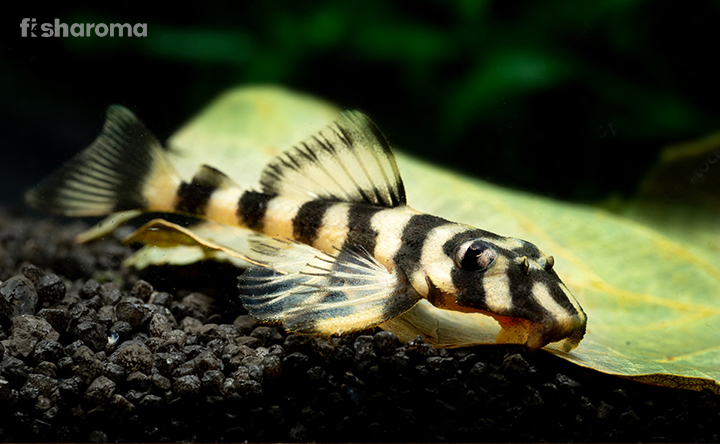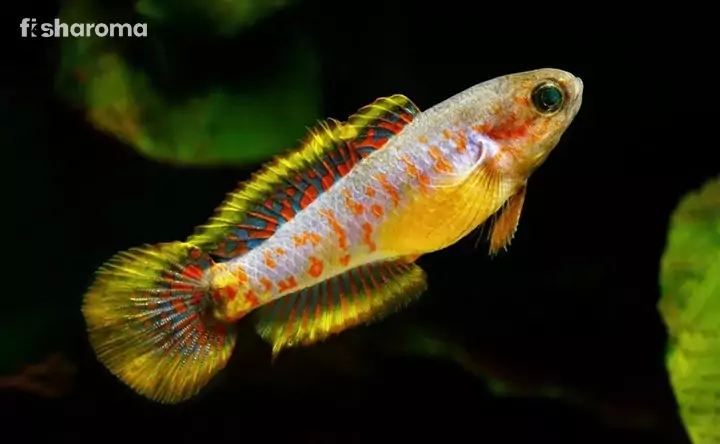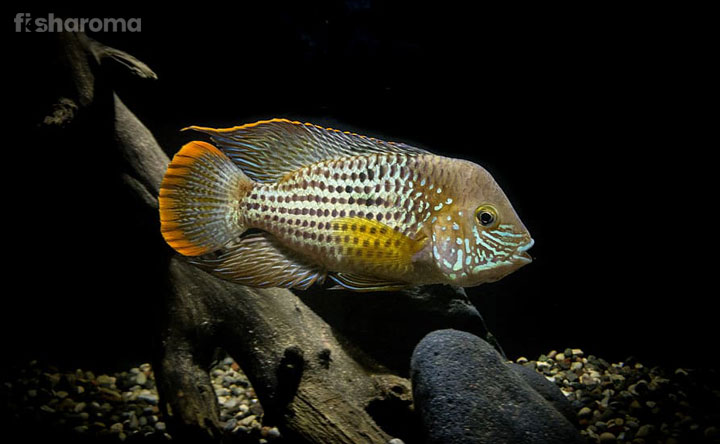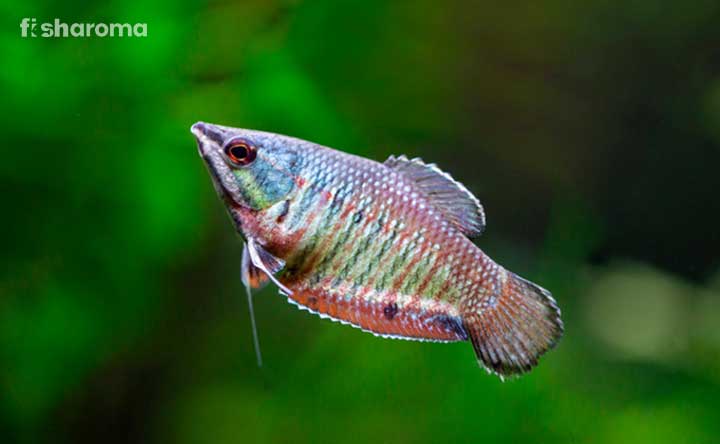Denison Barb and Its Complete Care Guide

Denison Barb is a small species of fish, gaining popularity, because of its tremendous attractive appearance. However, the fish has been so discussed, that their natural existence is at stake nowadays. As far as the breeding market is concerned, they have plenty of such fishes, so the species is thriving in captivity more than it does in nature.
Now coming to its care and maintenance, you can always be sure that this fish needs basic things. From its diet to its tank, everything is pretty reasonable, even for the aquarists.
Key Specifications Of Denison Barb
The Denison Barb is a nice species to care for, and the following chart will be a shortcut way to know the most important aspects of the species.
| Also Known As | Roseline Shark, Red-line Torpedo Barb, Miss Kerala, Denison’s Barb, Bleeding Eye Barb, Denison’s Flying Fox |
| Origin | India |
| Lifespan | Around 5 years |
| Colours | Grey, black, yellow with iconic red and black marks |
| Temperament | Peaceful |
| Size | Around 6 inches |
| Diet | Omnivorous |
| Reproduction | Egg-laying |
| Maintenance Requirements | Easy |
| Tank Size | 55 gallons at least |
| IUCN Conservation Status | Endangered |
Overview
The south Indian species of fish, scientifically known as Sahyadria denisonii, belongs to the Cyprinidae family. Its small size, and easy to handle nature is ideal for any enthusiasts who would like to own one. This shoaling species loves to stay within their own community inside the tank. They are not demanding about anything in particular and when properly cared for, they can survive for around 5 years in captivity. However, a few exceptional cases are not unlikely to occur, as many breeders found such fishes with better and longer lifespans. Their egg-laying reproduction process makes them easy to breed in the pet trade as well. So, if there are any doubts from your end, clear the air by reading the following one.
Origin And Habitat Of Denison Barb
The Denison Barb is originally from the Southern states of India, Kerala and Karnataka. They are actually found in the Western Ghat or, rather more specifically in the Malabar Coast. Their origin is around the Rivers of Chaliyar, Pamba, and Achenkovil.
Their habitat is amidst the rocky rivers and streams surrounded by heavy plantations. The water current is fast flowing throughout their distribution.
Appearance Of Denison Barb
The body of the fish has a typical torpedo-shape, coloured with multiple hues. Sexual dimorphism is present because males are smaller than female fishes and the former has bright colouration.
Size
An adult Denison Barb grows to be around 6 inches maximum.
Colour
The grey-based body has shimmery scales, with a couple of black and red lines stretching across horizontally. While the black line is stretched from the snout to the end of the body the red line ends halfway. The red tint is present in the dorsal fin and the caudal fin exhibits a combination of yellow and black. The adult fishes have a greenish tint on their head.
Behaviour Of Denison Barb
These fishes love to swim fast, and they are always agile, going from one side to another. Their peaceful disposition is observed only when their criterion for sufficient swimming space is provided. Or else, the fish can get stressed and showcase their rude and violent behaviour.
They are always eager to receive food, of any sort, and in this case, they have less fuss. The overall behaviour of a Denison Barb is peaceful, and they don’t mind showing their beautiful colouration to the onlookers, by swimming in a group of their own members.
Lifespan Of Denison Barb
An average Denison Barb lives for around 5 years, but your care and maintenance can enhance the quality of its life. Some breeders can have Denison Barbs, with a longer lifespan, but those are exceptional and you shouldn’t set your expectations. Just remember that your job is to take care of your pet fish so that it can lead a healthy life, regardless of its span.
Diet Of Denison Barb
Denison Barbs are omnivorous species, and they can consume almost anything that you will offer. Pet fishes are usually excited whenever they find that food is being provided and chasing the food is one of their natural instincts. While in the wild river they are comfortable having invertebrates, insects, aquatic plants and algae, in a tank set-up, they can do well on live or frozen food.
Make sure that you are feeding them twice, and not a single time more. Overfeeding will lead to many digestive disorders. Now we will discuss the items that you will incorporate into their diet. Since they have the chasing tendency, you better choose foods that are slow sinking, giving much time to the fish to consume their food before the sinking pellet touches the ground. Otherwise, the Barbs can become aggressive if they need to dig their food from the bottom. They turn out to be competitive with their own members for the same situation.
Live and carnivorous diet includes
- Daphnia
- Brine Shrimp
- Cyclope
- Bloowdworm
- Earthworm
You can give these items either in live or frozen forms. As far as vegetables are concerned, give them
- Spirulina
- Algae
- Blanched vegetables
Dried flakes or pellets are also good options that you can provide occasionally. These have usually low nutrition value, so you have to mix and match the above-mentioned items so that the fishes can have a varied diet. This way, they won’t lack nutritional value. That helps maintain the bright colouration of Denison Barbs.
Tank Requirements Of Denison Barb
The Denison Barb needs a big tank because of its immense swimming zest. Also, they are inquisitive in nature, so a large tank with lots of decorative objects is ideal for them. Remember that you need to provide something that will keep them busy, for which, a well-planned tank should be your ultimate choice. If they are happy with their tank, then you will see a group of happy Denison Barbs playing and swimming jovially in the tank, exhibiting their riot of colours.
Tank Size
For a small group of Denison Barbs, you can use a 55-gallon tank. They need a wide swimming zone, so there shouldn’t be any compromise. If you want to keep a community tank or a bigger group of fishes then opt for a bigger fish tank.
Tank Lid
A tank lid is mandatory because these fishes are adventurous and wouldn’t hesitate to jump out of the tank every now and then. However, that is quite dangerous and to prevent such accidents, make sure your tank has a proper lid all the time.
Substrate
Most of the Denison Barbs prefer to swim through the upper level of the water, but that doesn’t lessen the importance of making a perfect substrate for them. Their natural habitat is rocky waterbeds and to emulate the same setting you should keep colourful pebbles and rocks at the bottom. Choose either gravel or a sandy surface for your Denison Barb.
Filter
As informed previously, the fishes stay in waters with fast current so you need to use a strong filter that can produce and maintain high flow of the tank water. The oxygen level should also be high as that is how the Denison Barbs’ natural habitat is.
For the fast flow, you can use a water pump instead of a filter, although our recommendation is that you should go for an External Canister Filter or Internal Power Filter. Such filters usually have an outlet or vent aligning with the water surface, and facing downwards for effectively producing oxygen and strong water current.
Ornaments
These fishes are always ready to explore their surroundings so give them the chance by decorating the tank with proper driftwoods, hiding places, and other ornamental decors.
Some rock caves or castles are also good alternatives.
Lighting
There is nothing in particular, preference wise, when it comes to tank light. You can easily keep some lights that are neither too strong nor too low for the fish. Also, you need to see the colourful fishes gracing your tank, so fit lights accordingly. Don’t forget that the colours of such fishes are at their best when proper lights fall on them.
Presence Of Flora
Plants are important but you have to play smart here because Denison Barb is famous for uprooting plants. You need to make sure that the plants you are placing should be well-anchored. Java Fern and Anubias are two ideal alternatives that you can think of. The plants will ensure the oxygen flow and also offer some hiding or resting places for these Denison Barbs.
Cleaning Methods
Performing a regular cleaning regime includes cleaning of decorative items from the tank, and rinsing and wiping off excess algae with an algae scraper. Cleaning is an integral part of maintenance and you should never skip this. Clean the tank weekly so that the water quality remains good and suitable for the fishes.
Water Type For Denison Barb
In the natural domain of Denison Barb, the water is rocky, clean, and acidic in nature. You have to maintain the same water parameters so that the beautiful Barb doesn’t just exist, rather stay comfortable and thrive successfully.
Temperature
Denison Barbs stay well in 15.5- 25 Degrees Celsius. Something middle in the temperature zone would be the best for the Barbs.
pH Level
The ideal pH level of the water should be ranging from 6.6-7.8.
Hardness
The general hardness of the water should be 5-25 dGH.
Mineral
The Ammonia and Nitrite should be 0 ppm while the Nitrate should be less than 10 ppm.
Replacement Procedure
The water change should be done every week and that should include partial water replacement. Like, 25% of water should be changed every week because if more water is changed, that might shock the fish.
Compatibility Of Denison Barb
Denison Barbs are schooling fishes and they are at their best when kept in a group of 5-7. You can always increase the number, but the tank size should be larger accordingly as well. If you keep just a Barb-specific tank, there might be some fights to determine the leader of the Barb group. Once that is decided, everybody, cohabits peacefully maintaining the hierarchy. The largeness of the group comforts the Barbs and they can actually swim showcasing their colours at their optimum best.
Suitable Tank Mates
These Barbs are good to be with other species of fishes , but their water criteria and temperament need to be the same. Also, the tank mates need to be fast swimmers, just like the Denison Barbs, otherwise there will be a clash, and slow swimmer fishes might get bullied by the Barbs. The compatible tank mates are listed below
- Rainbow Barb
- Tiger Barb
- Rosy Barb
- Cherry Barb
- Celestial Pearl Danio
- Siamese Algae Eater
- Kribensis Cichlid
- Corydoras Catfish
- Zebrafish
- Snails
- Shrimps
- Tetra Speices
Unsuitable Tank Mates
Aggressive or slow-moving fishes are not compatible with Denison Barbs. They don’t get along well and neither their cohabitation is healthy for them. There will be fights, injuries, and stress observed. We are naming a few;
Breeding Of Denison Barb
Breeding of Denison Barb in a homely tank set-up is next to impossible, as it has never happened. Only in commercial breeding, with some hormonal injections, spawning is encouraged followed by female Barbs scattering eggs on aquatic plants. From multiple breeding sources, it has been observed that their breeding ambience requires acidic and soft water.
Diseases Of Denison Barb
Denison Barbs can commonly be a victim of Ich, which is marked by white spots all over the body. This is either by stress, poor water quality, and other hygiene-related issues. You can prevent that by maintaining the standard of the tank water.
Apart from these, there are some common fish diseases that can also attack the fish. It is best to keep the tank clean, feed the fish properly, and look out for odd postures of the fish. If such agile fishes suddenly start hiding, refuse to eat, and stay in sedentary positions for a long time, then make sure that they are affected by stress.
Summary
The colourful Denison Barb is a fast swimmer and belongs to the category of colourful freshwater fishes. They are omnivores by nature and make a great addition to your community fish tank. Although breeding them in captivity is a bit difficult for beginner aquarists and it takes a lot of external help to actually make them breed, their numbers in captivity are thriving, unlike their wild population.
Other Similar Care Guides
- Bleeding Heart Tetra – The tetra species looks absolutely breathtaking, justifying its name. This is a freshwater fish, with an egg-laying breeding process.
- Cardinal Tetra – The Cardinal Tetra is a colourful species that is known for its immense beauty. This fish is actually a fast swimmer, much like the Denison Barb.
- Ryukin Goldfish – The fancy Goldfish is known for being a wonderful tank fish. It loves to eat and never fails to entertain the owner with its flowy fins.









